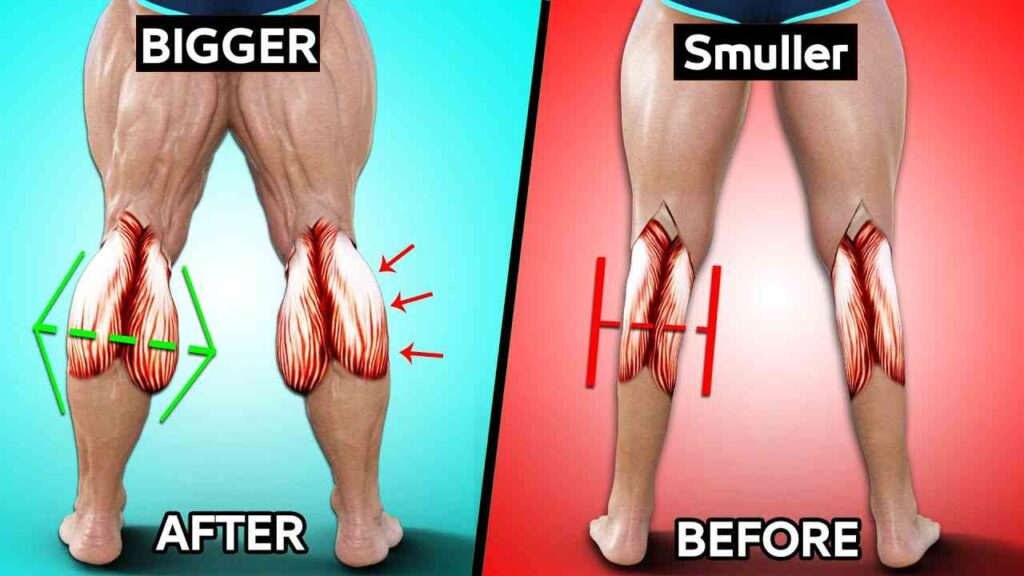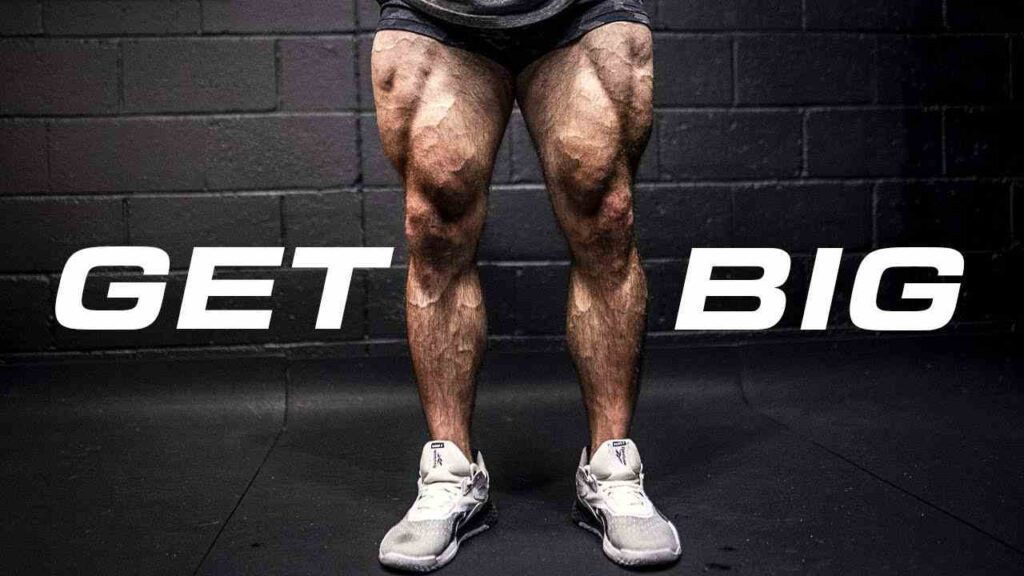Calf raises, a simple yet effective exercise targeting the muscles of the lower leg, have long been a staple in fitness routines worldwide. Whether you’re a seasoned athlete aiming to enhance performance or a casual gym-goer looking to strengthen your lower body, calf raises offer a multitude of benefits. However, amidst the enthusiasm for sculpted calves and improved athletic prowess, a pertinent question arises: Is it okay to do calf raises every day?
In this article, we delve into the intricacies of calf training, exploring the physiological implications, potential risks, and optimal training frequency for maximizing gains while safeguarding against overuse injuries. From understanding the anatomy of the calf muscles to deciphering the science behind muscle recovery, we aim to provide a comprehensive guide for individuals seeking to incorporate calf raises into their daily workout regimen.
Anatomy of the Calf Muscles
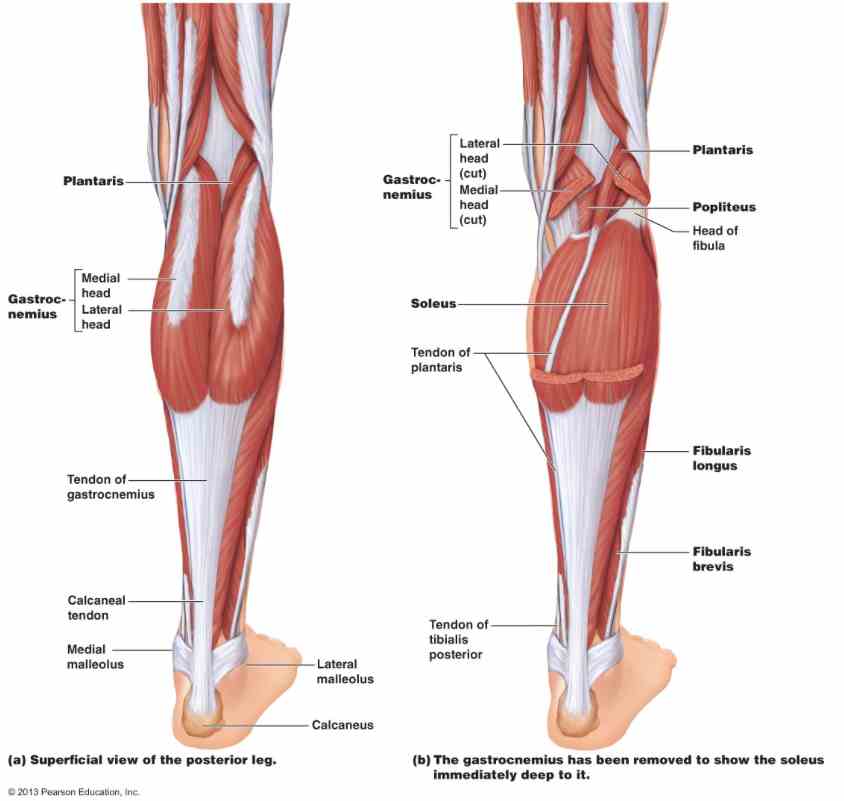
The calf muscles, comprised mainly of the gastrocnemius and soleus muscles, are vital for lower body movement and stability. Here’s a breakdown of their anatomy:
- Gastrocnemius Muscle: This is the larger, more superficial muscle of the calf. It forms the bulge visible beneath the skin when you point your toes or stand on tiptoes. The gastrocnemius originates from two heads, the medial head, which originates from the medial femoral condyle, and the lateral head, which originates from the lateral femoral condyle. Both heads merge into the Achilles tendon, which inserts into the heel bone (calcaneus). The primary function of the gastrocnemius is plantar flexion of the foot (pointing the toes downward) and assisting in knee flexion.
- Soleus Muscle: The soleus lies underneath the gastrocnemius and is often referred to as the “second heart” due to its role in pumping blood back to the heart during movement. It originates from the posterior surfaces of the tibia and fibula bones and also inserts into the Achilles tendon. Unlike the gastrocnemius, the soleus is primarily involved in plantar flexion of the foot and is more active during movements where the knee is bent, such as when squatting.
- Achilles Tendon: This thick, fibrous tendon connects the calf muscles (gastrocnemius and soleus) to the heel bone (calcaneus). It is one of the strongest tendons in the body and is crucial for activities such as walking, running, and jumping.
- Blood Supply and Innervation: The calf muscles receive their blood supply from branches of the popliteal artery and are innervated by the tibial nerve, a branch of the sciatic nerve.
Understanding the anatomy of the calf muscles is crucial for performing exercises like calf raises effectively and safely.
Benefits of Daily Calf Raises
Calf raises offer several benefits, making them a valuable addition to any workout routine:
- Strengthening the Calf Muscles: Calf raises primarily target the gastrocnemius and soleus muscles, helping to strengthen and tone these muscles. Strong calf muscles are essential for activities like walking, running, jumping, and climbing stairs.
- Improved Ankle Stability: Strong calf muscles contribute to better ankle stability, which is crucial for maintaining balance and preventing ankle injuries during various physical activities and sports.
- Enhanced Athletic Performance: Athletes, especially those involved in sports like basketball, volleyball, and sprinting, can benefit from calf raises to improve their vertical jump and explosive power. Strong calf muscles provide the necessary propulsion for these dynamic movements.
- Injury Prevention: Strengthening the calf muscles can help prevent common lower leg injuries such as Achilles tendonitis, calf strains, and shin splints. By building strength and resilience in these muscles, individuals can reduce the risk of overuse injuries during physical activity.
- Improved Muscle Definition: Regularly performing calf raises can help enhance muscle definition and aesthetics in the lower leg, creating a more sculpted appearance.
- Balance and Coordination: Calf raises engage the stabilizing muscles around the ankle joint, which can improve balance and coordination, benefiting individuals of all ages and activity levels.
- Rehabilitation: Calf raises are often included in rehabilitation programs for lower leg injuries to rebuild strength, flexibility, and range of motion in the calf muscles and surrounding tissues.
Best Squat Techniques for Quads
Overall, incorporating calf raises into your fitness routine can provide a range of benefits for both athletic performance and everyday function, contributing to a stronger, more resilient lower body.
Risks of Overtraining the Calf Muscles
Overtraining the calf muscles can lead to various risks and negative outcomes, including:
- Muscle Fatigue and Soreness: Overtraining can lead to excessive fatigue and soreness in the calf muscles, making it difficult to perform daily activities and affecting overall mobility.
- Decreased Performance: Overworked muscles may not perform optimally, leading to decreased athletic performance in activities such as running, jumping, or other lower-body movements that heavily rely on the calf muscles.
- Increased Risk of Injury: Overtraining increases the risk of overuse injuries such as Achilles tendonitis, calf strains, and stress fractures. Continuously stressing the calf muscles without adequate rest and recovery time can weaken them, making them more susceptible to injury.
- Imbalance and Altered Gait: Overdeveloped calf muscles can create muscle imbalances and alter the natural gait pattern, potentially leading to issues such as knee pain, hip misalignment, and lower back pain.
- Plateau in Progress: Overtraining can hinder muscle growth and strength gains as the muscles do not have sufficient time to recover and adapt to the training stimulus. This can result in a plateau in progress despite consistent effort.
- Chronic Fatigue and Burnout: Overtraining the calf muscles, along with other muscle groups, can contribute to overall chronic fatigue and burnout, both physically and mentally. This can negatively impact motivation, mood, and overall well-being.
- Compromised Joint Health: Overworking the calf muscles without proper rest can lead to increased stress on the ankle joint and surrounding ligaments, potentially contributing to joint stiffness, inflammation, and long-term joint health issues.
- Decreased Flexibility: Overdeveloped calf muscles with limited flexibility due to overtraining can lead to reduced range of motion in the ankle joint, making it difficult to perform movements that require dorsiflexion, such as squatting or lunging.
Does Lifting Weights Make You Less Flexible?
To mitigate these risks, it’s crucial to incorporate adequate rest days into your workout routine, vary your exercises to target the calf muscles from different angles, prioritize proper form and technique, and listen to your body’s signals to avoid pushing beyond your limits.
Variations and Progressions
Here are some variations of calf raises and strategies for progressively overloading the calf muscles over time:
Standing Calf Raises
- Stand with your feet hip-width apart on a flat surface.
- Rise onto the balls of your feet as high as possible, lifting your heels off the ground.
- Lower your heels back down to the starting position.
- To increase difficulty, hold dumbbells in each hand or use a calf raise machine at the gym.
Seated Calf Raises
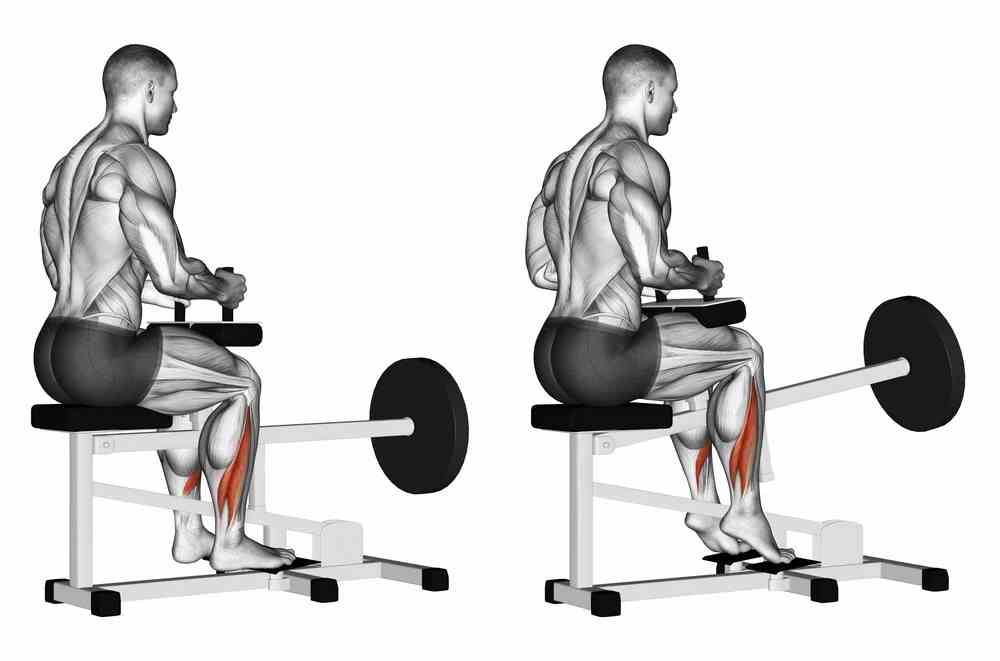
- Sit on a chair or bench with your feet flat on the ground and your knees bent at a 90-degree angle.
- Place a weight plate or dumbbell on your thighs for resistance.
- Raise your heels as high as possible by pushing through the balls of your feet.
- Lower your heels back down to the starting position.
- You can also perform this exercise on a seated calf raise machine at the gym.
Single-Leg Calf Raises
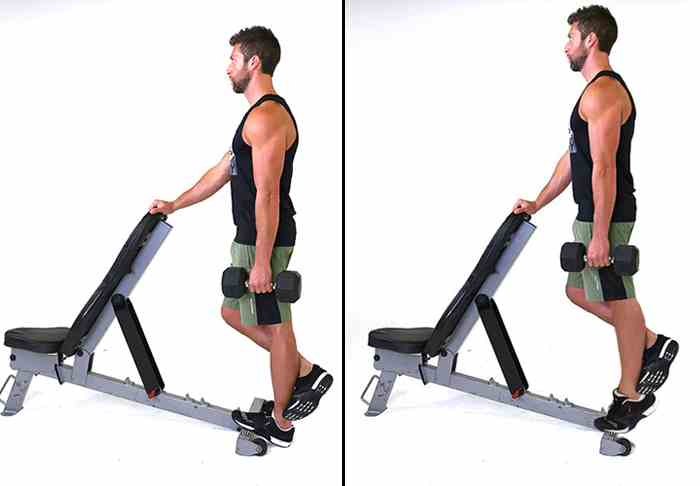
- Stand on one foot with the other foot lifted slightly off the ground or crossed behind the standing leg.
- Rise onto the ball of your foot, lifting your heel as high as possible.
- Lower your heel back down to the starting position.
- This variation challenges balance and stability while targeting each calf individually.
Eccentric Calf Raises
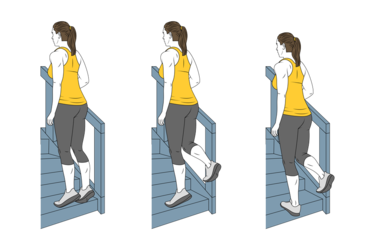
- Stand on a raised surface such as a step or platform with your heels hanging off the edge.
- Rise onto the balls of your feet.
- Slowly lower your heels below the level of the step, allowing your calf muscles to lengthen under tension.
- Use your hands or support for balance if necessary.
- Focus on the controlled lowering phase of the movement to emphasize eccentric muscle contraction.
Plyometric Calf Raises
- Perform a standard calf raise but with an explosive upward movement.
- As you rise onto the balls of your feet, push off the ground with enough force to lift your feet off momentarily.
- Land softly and immediately transition into the next repetition.
- Plyometric calf raises help to develop power and explosiveness in the calf muscles.
Donkey Calf Raises
- This exercise is performed using a specialized machine, typically found in gyms, where you lean forward with your hands braced on a pad or support and your feet positioned on a platform below.
- The movement involves raising your heels as high as possible while keeping your legs straight, targeting the gastrocnemius muscle primarily.
Box or Elevated Surface Calf Raises
- Stand on an elevated surface such as a box, step, or curb with the balls of your feet positioned on the edge and your heels hanging off.
- Lower your heels below the level of the platform, then push through the balls of your feet to raise your heels as high as possible.
- This variation allows for a greater range of motion compared to flat ground calf raises, targeting both the gastrocnemius and soleus muscles effectively.
To progressively overload the calf muscles over time:
- Increase Resistance: Gradually increase the amount of weight lifted during calf raises by adding dumbbells, using a weighted vest, or adjusting the resistance on a calf raise machine.
- Adjust Reps and Sets: Increase the number of repetitions and sets performed during calf raises as your strength improves. Start with 2-3 sets of 10-15 reps and gradually work up to 3-4 sets of 8-12 reps or more.
- Change Tempo: Experiment with different tempos, such as slow eccentrics or explosive concentrics, to challenge the muscles in new ways and stimulate growth.
- Progressive Overload Principle: Continuously challenge your calf muscles by progressively increasing the intensity, volume, or complexity of your calf raise workouts over time.
- Incorporate Variety: Rotate between different variations of calf raises to target the muscles from different angles and prevent adaptation. Mix up your routine by including standing, seated, single-leg, and plyometric calf raises.
- Rest and Recovery: Allow adequate time for rest and recovery between calf workouts to give your muscles time to repair and grow stronger. Avoid overtraining by scheduling rest days or incorporating active recovery activities such as stretching or foam rolling.
Is Barefoot Running Good for You?
By incorporating these variations and progressive overload strategies into your calf raise routine, you can effectively target and strengthen your calf muscles while minimizing the risk of overuse injuries.
Proper Technique of Calf Raises
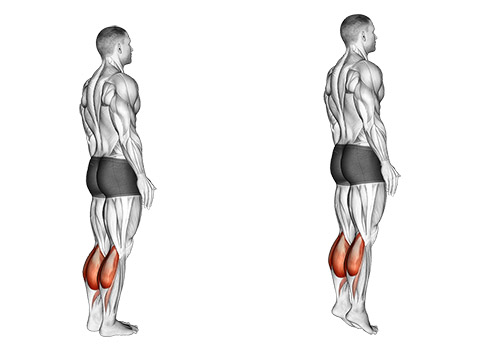
Maintaining correct form during calf raises is crucial for several reasons. It ensures that the targeted muscles, primarily the gastrocnemius and soleus, are effectively engaged, leading to better strength gains and muscle development. Proper form also minimizes the risk of injury by avoiding unnecessary strain on the surrounding tendons and joints.
Here are some tips to maintain balance and alignment during calf raises:
- Start Position: Begin by standing on a level surface with your feet hip-width apart and toes pointing forward. Ensure your posture is erect, shoulders pulled back, and core engaged.
- Movement Execution: Push through the balls of your feet to raise your heels off the ground. Keep your ankles aligned, avoiding any outward or inward rotation. This will help contract the calf muscles effectively.
- Controlled Motion: Raise your heels slowly and pause at the top of the movement to maximize muscle activation. Then, lower your heels back down with control, maintaining proper ankle alignment throughout.
- Balance Aids: If you’re a beginner or find it challenging to maintain balance, consider holding onto something stable like the back of a chair, a wall, or a railing. This can help you focus on muscle contraction without worrying about losing your balance.
- Footwear: Wear thin-soled shoes or perform the exercise barefoot to gain more contact with the ground, which can enhance your balance and the effectiveness of the exercise.
- Avoid Locking Knees: Keep a slight bend in your knees throughout the exercise to prevent joint strain and maintain a natural leg alignment.
By following these tips, you can perform calf raises with proper form, ensuring safety and maximizing the benefits of the exercise. Remember, it’s not just about doing the movement; it’s about doing it right to see the best results and prevent injuries.
Frequency and Volume
The optimal frequency and volume of calf raises can vary depending on individual fitness goals. Here’s a breakdown of recommended frequencies and volumes for different objectives:
Muscle Endurance and Toning:
- Frequency: Perform calf raises 2-3 times per week.
- Volume: Aim for 2-3 sets of 15-20 repetitions per session.
- Focus on using lighter weights or body weight to target endurance and toning of the calf muscles.
Muscle Growth (Hypertrophy):
- Frequency: Incorporate calf raises into your workout routine 2-4 times per week, allowing at least 48 hours of rest between sessions.
- Volume: Perform 3-5 sets of 8-12 repetitions per session.
- Use moderate to heavy weights that challenge your muscles and promote hypertrophy. Progressive overload is key to stimulating muscle growth over time.
Strength and Power:
- Frequency: Include calf raises in your routine 2-3 times per week.
- Volume: Aim for 3-4 sets of 4-8 repetitions per session.
- Focus on using heavier weights or explosive movements to target strength and power development in the calf muscles.
Rehabilitation and Injury Prevention:
- Frequency: Depending on the severity of the injury and guidance from a healthcare professional, perform calf raises as part of a rehabilitation program, typically 2-3 times per week.
- Volume: Start with lower volume and intensity and gradually increase as tolerated. Begin with 1-2 sets of 10-15 repetitions and progress from there.
- Emphasize controlled movements, proper form, and gradually increasing range of motion to aid in rehabilitation and prevent re-injury.
Maintenance and General Fitness:
- Frequency: Perform calf raises 1-2 times per week to maintain calf muscle strength and function.
- Volume: Complete 2-3 sets of 10-15 repetitions per session.
- Use a moderate intensity to keep the muscles engaged and prevent detraining without overloading them.
Is It Safe to Do HIIT Every Day?
Regardless of the fitness goal, it’s essential to listen to your body, gradually progress in intensity and volume, and allow for adequate rest and recovery between sessions.
FAQs
Q 1. What equipment do I need to perform calf raises?
Ans. You don’t necessarily need any equipment to perform basic calf raises. However, for variations like weighted calf raises, you might need dumbbells, a barbell, or a calf raise machine.
Q 2. How long should I rest between sets of calf raises?
Ans. A rest period of 30-60 seconds between sets is generally recommended. However, this can vary based on the intensity of your workout and your fitness level.
Q 3. What should I do if I feel pain during or after performing calf raises?
Ans. If you feel pain during or after performing calf raises, it’s important to stop the exercise immediately to avoid injury. Consult with a healthcare professional or a certified fitness trainer to ensure you’re performing the exercise correctly and to rule out any potential injuries.
Q 4. Can I do calf raises if I have a history of ankle or knee injuries?
Ans. If you have a history of ankle or knee injuries, it’s crucial to consult with a healthcare professional before incorporating calf raises into your workout routine. They can provide guidance on whether this exercise is safe for you and suggest modifications if necessary.
Q 5. What are some common mistakes to avoid when performing calf raises?
Ans. Common mistakes include rushing through the movement, not using a full range of motion, and not keeping your core engaged. It’s important to perform the exercise slowly and with control to get the most benefit.
Q 6. Can calf raises help improve my performance in other sports or physical activities?
Ans. Yes, calf raises can help improve your performance in activities that require strong and stable lower legs, such as running, hiking, and various sports. They can also help improve your balance and stability, which can be beneficial in many different physical activities.
Conclusion
In conclusion, calf raises are a versatile and effective exercise that can be incorporated into your daily routine. They offer numerous benefits such as improved balance, increased ankle stability, and enhanced lower leg strength. However, like any exercise, they should be performed correctly and with proper form to avoid injury. While it’s possible to do calf raises every day, it’s important to listen to your body and give your muscles time to recover and grow. Remember, everyone’s body is different and what works for one person may not work for another.

Good day, and welcome to Fitthour. My name is Shubham Vijay, and I am a certified personal trainer and nutrition coach with 6 years of experience in the fitness industry. At Fitthour, we specialize in types of training, such as strength training, cardio, or HIIT, and our mission is to help clients achieve their fitness goals and improve their overall health.

